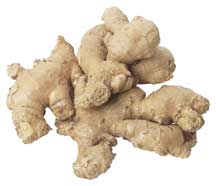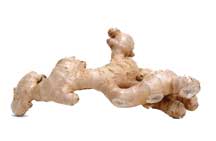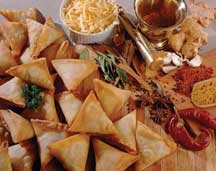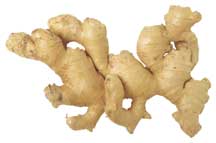Arts
What Does A Monkey Know About The Taste Of Ginger?

Nothing. But Indians sure know a lot!
|
“We hope you didn’t forget it!” they said. “I did not!” she replied. The place was a beautiful beach house on the New Jersey shoreline and the bunch of Indian American houseguests were whipping up some morning tea. Their American hostess had thoughtfully provided teabags, milk, muffins, cereal, bread and eggs. Only one essential ingredient was missing – but have no fear, the diehard desis had brought that along in a Ziploc bag – freshly chopped ginger for their morning cuppa! It’s amazing how “Indian” tea tastes once you brew it with milk, sugar and plenty of finely sliced ginger. For many desis, it’s a must-have after growing up in India and makes the beverage totally satisfying, with an incomparable punch, a “sock it” feeling.
The ginger root is a knobby ugly looking thing, but it’s truly beautiful on the inside, a natural, almost spiritual, toner for the body. Ask any Indian and they will relate tales of how their mother gave them a spoonful of ginger juice as a sure-fire cure for everything from sore throats and colds to motion sickness. Ginger was almost automatically added to every dish for improving digestion and taste. Little wonder then that a well-known proverb in Hindi is Bandar kya jaane adrak ka swad? -What does a monkey know about the taste of ginger? The implication is that the ignorant can’t appreciate quality, the equivalent of casting pearls before swine. Today almost everyone, save for the monkey – knows the value of ginger, both as a taste agent and a health aid. Ginger is vital to most Asian cuisines and pops up in many Western cuisines too. Indians call it adrak in its green form and sonth in its dried form; the Spanish call it jengibre, the Italians zenzero, the French gingembre, the Indonesians aliah and the Thai call it khing. But they all agree on its importance in their cuisines and health. Ginger has been around for centuries and everyone from the ancient Greeks to Confucius to the Emperor Akbar is believed to have been a fan, not to mention the sage Vatsyayana, author of India’s famed sex manual, Kama Sutra, who recommended ginger as an aphrodisiac for lovers. This magical spice is derived from the root and rhizome of the perennial plant Zingiber officinale. Once peeled, the ginger root has a golden color. It is used both fresh and dried, and is grown in many parts of the world, but first originated in China, and then spread to India, other Southeast Asian countries, Africa and the Caribbean. In the U.S. it is grown in Hawaii. China leads in ginger production, followed by India, Nepal and Indonesia. Some recipes call for the fresh, tender ginger while others use the dry root, which is brown on the outside, but a lovely yellow color on the inside. Ginger is also available in dry, powdered form, as an extract and also in preserved, crystallized and candied forms. You can also get ginger tablets and capsules, but there’s nothing quite like fresh ginger.
According to Naveen Patnaik, author of The Garden of Life: An Introduction to the Healing Plants of India, a city with the Sanskrit name for ginger is mentioned in the Ramayana, indicating that in 200 BC this city was already the capital of the ginger trade. He says, “The Ayurveda calls dried ginger the ‘Great Medicament’ against colds, coughs, rhinitis, bronchitis and indigestion. It is prescribed for abdominal distention, colic diarrhea, and nausea. Infused in hot water it causes sweating and is used for breaking fevers. Applied externally it relieves rheumatic pain. Crushed ginger is rubbed on the forehead for the relief of headaches, while ginger juice is India’s mustard plaster, applied on children’s chests when they are suffering from colds and bronchitis. Fresh ginger is chewed for sore throats and lost voices, and ginger candies are used as throat lozenges. Contemporary medicine considers ginger as a potent antidote to motion sickness as well as being anti-cholesterol and an anticoagulant.” Western countries too are waking up to the medicinal benefits of ginger. According to the Mayo Clinic, the rhizomes and stems of ginger have assumed significant roles in Chinese, Japanese and Indian medicine since the 1500s. The oleoresin of ginger is often contained in digestive, antitussive, antiflatulent, laxative and antacid compounds. Many first generation Indian immigrants to America who grew up in small towns and cities in India recognize ginger as a part of the medicine cabinet and the pantry. The knobbly brown ginger roots were ubiquitous in every market place, lying in small mounds on sheets in front of the vegetable seller in the bazaar, and after being judiciously inspected like jewels, they were taken home in shopping bags by cooks and memsahibs to be part of the daily meal. Ginger would find its way into the early morning tea, especially soothing and warming on cold, brisk mornings in cities like Delhi. It would be the taken-for-granted ingredient in curries and dry vegetables and pullaos and was the important marinade and tenderizer in meat dishes. And when a child had a cold or an upset stomach, ginger turned into a health aid. Jehangir Mehta, the chef and owner of the hip East Village café, Graffiti, has many childhood memories of ginger, not all pleasant. “Most of our food has ginger-garlic in it, but when I was growing up, unfortunately I had whooping cough and asthma, and people used to always tell my parents to give me lots of ginger. My poor parents would give me even more ginger than a regular child would get. After about a year, when my cough went on getting worse and worse, I went to an allergist and we found I had an allergy to ginger!” Fortunately the allergy completely disappeared as Mehta grew up and today he is a fan, using it in many of his dishes. At Graffiti, he does a very traditional pork dish in the manner of lamb dishes in his Zoroastrian community, braised with apricots and ginger. He also likes to pair scallops with pickled ginger, since the sweet and pungent tastes marry well. When immigrants came to America, they bought their home cures and folk remedies along, a legacy of mothers and grandmothers. It is surprising how many families still turn to ginger as the first remedy for coughs and colds, and even motion sickness. For Ambalika Mishra, a radio commentator who lives in New York, ginger is both a health aid and culinary must-have. Mishra, who hails from Agra, uses it for several home cures, from colds to nausea. She recalls when the weather turns cool, everyone starts drinking ginger tea, because it is warming. Last year when she visited home for a wedding, she was plagued by a dry cough, which had lasted almost a month. Her grandmother promptly had her chew a piece of ginger every day – and the cough was history. As soon as her own children have a cough or cold coming on, Mishra ministers them a spoonful of ginger juice mixed with honey, because it is effective and, unlike medicines, has no side effects. And then of course, there’s the added bonus of the superlative taste of ginger, which is a must in the construction of almost every Indian dish, no matter from which region. Says Mishra, “I always have ginger in my fridge. I put it in all my cooking, because it’s good for digestion.” In fact, from childhood she has served nimbu ki adrak, minced ginger soaked in lemon juice, with all the meals, along with pickles and chutneys as a dietary aid. The testimonials come from noted chefs too. “Ginger is a warming spice, and one of the legendary medicinal spices, used the world over for everything from a sore throat to an upset stomach,” says Floyd Cardoz, the noted chef of Tabla in New York, in his book, One Spice, Two Spice: American Food, Indian Flavors. Cardoz uses ginger in many recipes from Goan Spiced Crab Cakes to Indian-influenced French Onion soup. An article about the value of spices in the Knight Ridder newspapers noted, “Ginger earns its age-old reputation as a stomach-settler and a purifier. It has cholesterol-lowering, artery-degunking antioxidants and anti-fungal, blood-clotting and even cancer fighting properties. You can’t make Asian or Indian food without it. Or gingerbread! While the FDA doesn’t regulate spices, it categorizes all the above as GRAS (generally recognized as safe) so ban the bland and take your medicine – it’s delicious.” Ginger also has anti-inflammatory properties and Neal Barnard, MD, author of Foods That Fight Pain and president of the Physicians Committee for Responsible Medicine in Washington D.C., says, “It works like Ibuprofen, but without the side effects.” The benefits of ginger include relief from indigestion, nausea and reduction of inflammation associated with arthritis and rheumatism, and it is also helpful in alleviating asthma and bronchitis.
Researchers at the University of Michigan Comprehensive Cancer Center have started investigations which show promise for ginger as a potential ovarian cancer treatment, according to the journal BMC Complementary and Alternative Medicine. Ginger is effective in controlling inflammation, which contribute to the development of ovarian cancer cells. By halting the inflammatory reaction, the researchers suspect, ginger also stops cancer cells from growing. One of the researchers, J. Rebecca Liu, M.D., assistant professor of obstetrics and gynecology at the University of Michigan Medical School, told Little India: “The use of dietary agents such as ginger may have potential in the treatment and prevention of ovarian cancer. But other research from the University of Michigan has found that ginger is metabolized very rapidly after ingestion, so it may turn out to be more effective against gastrointestinal tumors, such as colon cancer. Much more research is needed to determine what, if any, role ginger can play in treating cancer.” With all its medical benefits, it helps that ginger also tastes great and is so vital to Indian cuisine. According to cooking expert Julie Sahni, fresh ginger is one of the three main seasonings – the other being onions and garlic – which form the base of most of sauces in North Indian cooking. In Classic Indian Cooking she notes that fresh ginger root is valued much more than garlic or onion, because of its extensive use in Indian vegetarian cooking. Garlic and onions are more commonly associated with non-vegetarian cooking and are often spurned by Jains and Hindu Brahmins. “Almost all curry recipes include ginger and garlic. The traditional method is to chop them finely and fry them along with the onions. They are usually used together, often in almost equal quantities,” writes Camellia Panjabi, author of 50 Great Curries of India. Ginger seems to be ubiquitous in almost all curries, be it the North Indian Rogan Josh, the West Indian Bori Curry, Mutton Curry Andhra style or fish in mustard sauce from East India. Ginger is an important ingredient in South Asian and Far East cuisines as well, and recipes call for everything from fresh ginger to ginger powder to crystallized ginger. Pickled ginger is popular in Asian cuisines and in India it is called ginger achaar. One can also sneak ginger into dishes that don’t usually list it as an ingredient, such as vegetable soup. There are of course many ways of getting your daily ginger dose and a teaspoonful of ginger juice or grated ginger is a popular accompaniment to Indian meals. There are also many ginger-laced drinks, from ginger ale to ginger beer to the many cooling gingery summer drinks in India. In the west you see the spice most often in jams, cookies and cakes while in Asian restaurants, meals often end with a ginger candy to help digestion. Ginger is now making it even into desserts, and Jehangir Mehta, whose new dessert book Mantra: The Rules of Indulgence showcases his bold juxtapositions of fruits and spices, often uses ginger in his creations. The trick, he says, is to combine ginger with milk products, chocolate or sorbets, which can absorb the pungent flavor. This rather strange looking rhizome may never be a celebrity in the mode of Ginger of the Spice Girls, but it’s vital to cuisine and well-being in many parts of the world. Its popularity in America has risen with each new immigrant group, which brings its own foods and culture to Main Street. As for the bunch of Indian Americans in the beach house, they started the day with ginger and ended it with ginger: the dinner at a Thai restaurant on the waterfront had the subtleties of ginger mixed in every flavorful bite. Those monkeys are certainly missing something!
|





